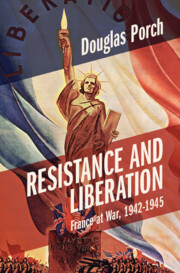Book contents
- Resistance and Liberation
- Armies of the Second World War
- Resistance and Liberation
- Copyright page
- Contents
- Figures
- Maps
- Preface
- Abbreviations
- 1 Tunisia
- 2 “A Sort of Resurrection of France”
- 3 Triumph and Dishonor in Italy
- 4 Resistance on the Eve of D-Day
- 5 “The Supreme Battle”
- 6 Anvil/Dragoon
- 7 L’amalgame
- 8 Les Vosges
- 9 Rhine and Danube
- 10 Conclusion
- Notes
- Bibliography
- Index
8 - Les Vosges
Published online by Cambridge University Press: 05 January 2024
- Resistance and Liberation
- Armies of the Second World War
- Resistance and Liberation
- Copyright page
- Contents
- Figures
- Maps
- Preface
- Abbreviations
- 1 Tunisia
- 2 “A Sort of Resurrection of France”
- 3 Triumph and Dishonor in Italy
- 4 Resistance on the Eve of D-Day
- 5 “The Supreme Battle”
- 6 Anvil/Dragoon
- 7 L’amalgame
- 8 Les Vosges
- 9 Rhine and Danube
- 10 Conclusion
- Notes
- Bibliography
- Index
Summary
One of de Gaulle’s great successes in the Second World War was to allow France to punch above its weight in the Alliance. However, the French army struggled to match in military proficiency de Gaulle’s lofty aspirations for French power and influence. The Vosges campaign proved yet another punishing trial for the French army. Its professional cadres seriously attrited in Tunisia, in Italy, and in the march from the Mediterranean coast, distant from its North African base, utterly dependent on the Americans for supplies, the command echelon riven by rivalries of a political, doctrinal, and personal nature, the poorly equipped First French Army was forced to endure a bitter campaign in the harshest of winter conditions, while simultaneously “amalgamating” clusters of poorly trained and disciplined FFI and volunteers. While the reconquest of Alsace and that of the “Atlantic pockets” were symbolically important to de Gaulle and the French, they were low priorities for the SHAEF commander, whose mission for Sixth Army Group was to “hold the flank” while advances were to be made further north. Eisenhower’s personal rivalry with Jacob Devers, combined with a lack of confidence in the volatile de Lattre and a rebuilding French army, possibly caused him to “miss opportunities” for an early crossing of the Rhine in late November 1944, and the disruption of the German Ardennes offensive, which caught him by surprise on 16 December. While Eisenhower blamed Devers and de Lattre’s timorousness and lack of mastery of armored warfare for the persistence of the Colmar Pocket, and pressured Sixth Army Group to eliminate it, he constantly diverted resources which might have allowed them to do so to Patton. Tensions between de Gaulle’s political agenda and Eisenhower’s operational focus, apparent since Algiers in 1942, exploded with the Strasbourg crisis of January 1945, which was successfully resolved only after Churchill’s intervention. However, the Allied failure to clarify the French role in the post-war occupation of Germany created conditions for further clashes between Eisenhower and the French during the culminating invasion of Germany.
Keywords
- Type
- Chapter
- Information
- Resistance and LiberationFrance at War, 1942-1945, pp. 477 - 536Publisher: Cambridge University PressPrint publication year: 2024

